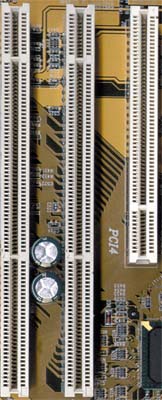Motherboards in 2000 Preview - Part 1: Chipsets
by Anand Lal Shimpi on December 6, 1999 12:44 AM EST- Posted in
- Motherboards
Intel's 840
 When
Intel was left with the introduction of a new CPU but no 133MHz FSB chipset
to run it on, they turned to the workstation/server level 840 chipset in order
to provide the first benchmarks on October 25, 1999. Upon the release of these
benchmarks, many people asked exactly where this i840 chipset came from, since
the most talked about solution was the i820.
When
Intel was left with the introduction of a new CPU but no 133MHz FSB chipset
to run it on, they turned to the workstation/server level 840 chipset in order
to provide the first benchmarks on October 25, 1999. Upon the release of these
benchmarks, many people asked exactly where this i840 chipset came from, since
the most talked about solution was the i820.
We actually expected the i840 to be featured on all dual processor boards, but it turns out that the i840 was a very difficult chipset to locate among the upcoming motherboards. We did bump into a few, but, for the most part, very little attention was paid to the chipset.
The i840 in its simplest form is a 3-chip solution like the i820 composed of the 82840 Memory Controller Hub (MCH), the 82801 I/O Controller Hub and 82802 Firmware Hub (FWH) the latter two we are already familiar with from the i820 and i810E platforms. The 82840 MCH provides support for dual RDRAM memory channels that increases the total peak memory bandwidth from 1.6GB/s of PC800 RDRAM on an i820 to 3.2GB/s of PC800 on an i840 board. This figure is very appetizing for high-end workstation users that are dependent on having a large amount of available memory bandwidth, but, at the same time, it is also a very expensive figure to back up with RDRAM.
The flexibility of the i840 chipset comes in the three chips that can be added to the initial 3-chip solution: the 82806 P64H, the 82803 MRH-R, and the 82804 MRH-S. The 82806 P64H is a 64-bit PCI Controller Hub that enables support for 33/66MHz 64-bit PCI slots.
 The
MRH-R is a RDRAM based Memory Repeater Hub that converts each memory channel
into two memory channels for greater memory capacity. We were not able to get
final figures on performance downsides, if any, to using the MRH-R.
The
MRH-R is a RDRAM based Memory Repeater Hub that converts each memory channel
into two memory channels for greater memory capacity. We were not able to get
final figures on performance downsides, if any, to using the MRH-R.
The MRH-S is, as you can probably guess, a SDRAM based Memory Repeater Hub that
acts as the MTH for i840 based motherboards. The performance penalty for using
the MRH-S should be the same on i840 boards as using an MTH on an i820 board.
The majority of 840 boards came equipped with an AGP Pro slot (right) rather than the AGP 4X slot found on the i820 boards. The difference between the AGP Pro specification and the AGP 4X specification lies in the amount of current delivered to the AGP slot. The AGP Pro slot calls for four times the electrical power of the standard AGP connector through the use of a physical extension onto the AGP slot, as can be seen to the right. This allows AGP 1X, 2X and 4X cards to be used in an AGP Pro slot while not allowing for AGP Pro cards to be used in anything but an AGP Pro slot. The AGP Pro transfer rates are still the 1.06GB/s we were given with the AGP 4X interface.
With the cost of an RDRAM based i820 system already high enough, one can only guess as to how costly an RDRAM based i840 system would be. It seems like the best option for servers and high end workstations is to stick to the BX/GX/NX platforms that have been running for the past year and a half and wait until the i840 matures a bit (and prices fall) before journeying into that arena.
For mission critical applications such as web/database serving where one crash can mean tainting your company's image, it's best to stick with a tried and true solution. While the i840 has no apparent problems with the design, the old adage "if it ain't broke don't fix it" can apply here as the BX/GX/NX platforms are perfectly viable options even for the demanding high-end market.










0 Comments
View All Comments